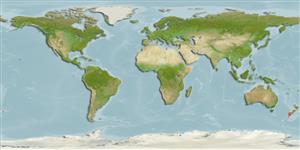Pycnogonida |
Pantopoda |
Ammotheidae
Environment: milieu / climate zone / depth range / distribution range
Ecology
Benthic; depth range 0 - 24 m (Ref. 9). Subtropical
Southwest Pacific: New Zealand.
Length at first maturity / Size / Weight / Age
Maturity: Lm ? range ? - ? cm Max length : 1.6 cm LS male/unsexed; (Ref. 9)
Size: small, leg span more than 1.6 cm. Trunk: compact, lateral processes contiguous at their bases, spreading distally. Trunk second and third segments with tall conical tubercles, no first or forth segment. Ocular tubercle: a cone, eyes small. Abdomen: erect, longer than trunk tubercles, with conical dorsodistal tubercle. Proboscis: ovoid. Chelifores: 2 segmented, scapes slender, with low dorsodistal tubercles, chelae small knobs. Palps: 9 segmented, 4 short segments with large extensions bearing small setae. Terminal segment down curved, resembling tubercles of previous 4 segments. Ovigers: conventional, strigilis with 7th segment apophysis and distal 3 segments placed anaxially on 7th. Legs: slender, with setae. Cement gland: a small bulge, pore slightly proximal to femoral rim. Propodus: typical, with 5 to 6 heel spines and several tiny sole spines. Claw: long, robust, 0.6 length of main claw (Ref. 9).
Depth based on occurrence record; to be replaced with better reference.
Life cycle and mating behavior
Maturity | Reproduction | Spawning | Eggs | Fecundity | Larvae
Members of the class Pycnogonida are gonochoric and sexually dimorphic. During copulation, male usually suspends itself beneath the female. Fertilization occurs as the eggs leave the female's ovigers. Males brood the egg masses until they hatch. Life cycle: Eggs hatch into protonymphon larva then to adults.
Child, C.A. 1998 The marine fauna of New Zealand: Pycnogonida (sea spiders). NIWA Biodiversity Memoire 109. National Institute of Water and Atmospheric Research (NIWA). Washington, D.C. 20530, USA. 71 p. + Figure 2A-G, 3A-F, 4, 5. (Ref. 9)
IUCN Red List Status
(Ref. 130435: Version 2025-1)
CITES status (Ref. 108899)
Not Evaluated
Not Evaluated
Threat to humans
Human uses
| FishSource |
Tools
More information
Trophic EcologyFood items (preys)
Diet composition
Food consumption
Predators
Population dynamicsGrowthMax. ages / sizesLength-weight rel.Length-length rel.Length-frequenciesMass conversionAbundance Life cycleReproductionMaturityFecunditySpawningEggsEgg developmentLarvae PhysiologyOxygen consumption
Human RelatedStamps, coins, misc.
Internet sources
Estimates based on models
Preferred temperature
(Ref.
115969): 3.4 - 16, mean 10.1 (based on 50 cells).
Fishing Vulnerability
Low vulnerability (10 of 100).
Price category
Unknown.
